Test-driven development flips the traditional workflow by asking developers to write tests before the code itself. For many teams, TDD can lead to a 40–90% reduction in defects and significantly lower maintenance costs. These results reflect real productivity and quality gains across mature software teams.
In essence, TDD reverses the traditional sequencing where tests are written before the implementation, creating a feedback loop that ensures every feature meets its requirements precisely.
Further, numerous industry reports and empirical studies have shown that teams adopting TDD experience significantly fewer bugs, faster debugging cycles, and improved release stability, especially in large-scale, complex software environments.
This disciplined process fosters cleaner, more maintainable code and simplifies issue detection early in the development cycle. Integrating TDD in software testing offers measurable improvements in quality and reliability.
In this blog, we will explore why TDD is a critical methodology in modern software engineering, supported with examples, benefits, and practical implementation strategies.
So, let’s begin by understanding what Test-Driven Development really is.
What is Test-Driven Development (TDD)?
TDD is a mindset that transforms how software is designed, built, and maintained. TDD shifts the focus toward precision, clarity, and early error detection by encouraging developers to write tests before writing actual code.
However, this technique supports the broader goals of modern engineering, such as delivering clean, maintainable, and bug-resistant software in fast-paced, collaborative environments.
Table of Contents
TDD follows a structured cycle known as “Red–Green–Refactor,” which repeats throughout the development process:
- Red:Write a test for a specific feature or behavior. Since the actual code doesn’t exist yet, the test fails.
- Green: Write the minimum amount of code required to make the test pass. This step ensures functionality is implemented to meet only the defined requirement.
- Refactor: Improve the existing code structure without changing its external behavior. The goal here is to clean up the logic, enhance readability, and ensure maintainability while keeping all tests green.
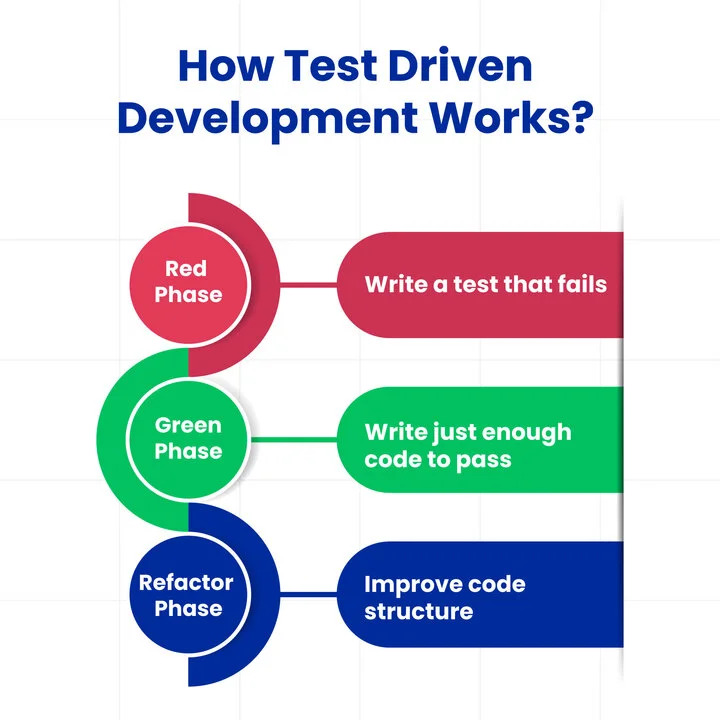
This cycle ensures that developers stay focused, write only the necessary code, and refactor with confidence, knowing the tests will immediately catch regressions. TDD not only improves code reliability but also builds a strong safety net for future development.
Defining Test-Driven Development in the Context of Modern Software Engineering
The definition of test-driven development has evolved with the demands of modern engineering practices. Today, it is recognized not just as a testing technique but as a core software design strategy.
TDD guides developers to think deeply about the system’s behavior even before its implementation begins, aligning with the needs of fast-paced Agile and DevOps workflows.
In practice, TDD ensures that each unit of code is backed by a test case, resulting in high test coverage and robust code.
Curious If TDD Fits Your Current Development Process?
Early adoption of TDD can lead to cleaner architecture, faster iterations, and fewer surprises down the line.
What is the Difference Between TDD And Traditional Testing Approaches?
Test-Driven Development differs significantly from traditional testing in its strategic mindset. Traditional testing typically occurs after the code is written, often as a separate step squeezed into the end of a sprint or development cycle.
This reactive approach can lead to missed bugs, overlooked edge cases, and rushed validation. In fact, according to Coralogix, developers introduce about 70 bugs per 1,000 lines of code, and debugging them can take up to 75% of their time. It highlights the cost of catching issues too late.
TDD, on the other hand, follows a test-first methodology. It prompts developers to write tests before the actual code, forcing them to think critically about expected behavior, constraints, and edge cases right from the start. This results in code that is more reliable and maintainable.
The following table below offers a side-by-side comparison to highlight how these two approaches differ:
| Aspect | Test-Driven Development | Traditional Testing |
|---|---|---|
| When Tests Are Written | Before writing the implementation | After the code is developed |
| Approach Type | Proactive—drives design and code structure | Reactive—validates existing code |
| Focus | Preventing bugs through early consideration | Finding bugs after development |
| Code Quality | Encourages clean, modular, and testable code | Often leads to tightly coupled or patchy code |
| Developer Mindset | Design-first; anticipates failure scenarios | Completion-focused; testing may be rushed |
| Feedback Loop | Continuous feedback during development | Delayed feedback, often post-implementation |
To conclude, TDD offers a more robust and thoughtful approach to software quality by shifting testing to the beginning of the development cycle.
Why is Test-Driven Development a Significant Development in Modern Software Engineering?
TDD has emerged as a foundational discipline in modern software engineering workflows. As teams increasingly adopt Agile methodologies, continuous integration, and DevOps practices, TDD offers a structured, test-first approach that enhances both speed and reliability.
Its value extends beyond individual productivity; it strengthens team collaboration, simplifies long-term maintenance, and improves release readiness across the entire delivery pipeline.
Let’s explore how TDD supports and advances today’s key engineering methodologies and practices.
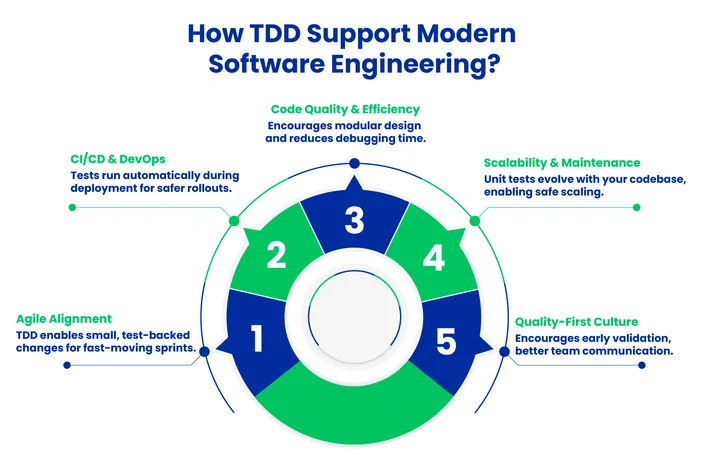
1. Aligning TDD with Agile and CI/CD Workflows
Agile development emphasizes short, iterative cycles and rapid delivery of working software with smooth implementation in DevOps and CI/CD solutions designed to automate deployments and tests.
In this context, agile and test-driven development are highly compatible. TDD supports agile principles by enforcing small, incremental changes backed by automated tests to allow developers to adapt to change without compromising stability.
Teams can ensure that every user story is supported by verifiable tests. by integrating TDD agile methodology, which aligns with the agile goal of “working software over comprehensive documentation.”
This continuous feedback loop increases team confidence and reduces time spent on regression issues.
2. TDD’s Role in CI/CD and DevOps Pipelines
Modern software engineering heavily relies on CI/CD pipelines to automate testing, integration, and deployment. Here, test-driven development in software testing acts as a vital layer of defense, catching bugs early and often.
When developers write tests first, these tests become part of the build process, enabling continuous validation as code moves through the pipeline.
TDD’s early testing approach reduces friction between development and operations, ensuring smoother handoffs, quicker rollbacks, and higher deployment confidence.
3. Increasing Code Quality Through Early Testing and Workflow Efficiency
A major benefit of test-driven software development is the consistent improvement in code quality. TDD encourages thoughtful design, as developers must define expected behavior before implementation. This practice naturally results in modular, testable, and well-structured code.
Moreover, the advantages of test-driven development extend to workflow efficiency. With fewer bugs, less rework, and higher test coverage, teams can focus more on innovation and less on firefighting.
TDD also supports code refactoring, making it easier to evolve systems without breaking existing features.
4. Enabling Scalable and Maintainable Software Systems
As software systems grow in complexity, maintaining quality across modules becomes more difficult. TDD addresses this by creating a reliable foundation of unit tests that scale with the codebase. These tests act as live documentation and allow engineers to trace, refactor, and optimize code with minimal risk.
This long-term maintainability is especially critical for enterprise systems or SaaS products that evolve rapidly and require frequent updates without service disruption.
5. Shaping a Quality-First Engineering Culture
Beyond tools and processes, TDD fosters a mindset shift, placing quality and validation at the heart of the development lifecycle. Teams that adopt TDD often develop stronger code review habits, better communication around feature requirements, and greater ownership of testing responsibilities.
Over time, this results in a quality-driven engineering culture where bugs are caught early, collaboration improves, and software is built with confidence from the start.
The theory is useful, but practice cements the habit. Here’s how to weave TDD into day-to-day coding.
Practical Implementation of TDD in Software Projects
While the theory behind Test-Driven Development is compelling, its true value is realized only through consistent, real-world application. To apply TDD effectively in software projects, teams must integrate tools, workflows, and habits that support early testing and continuous iteration.
Now that we’ve addressed TDD’s strategic role, let’s explore how development teams can bring this methodology to life in actual software projects.
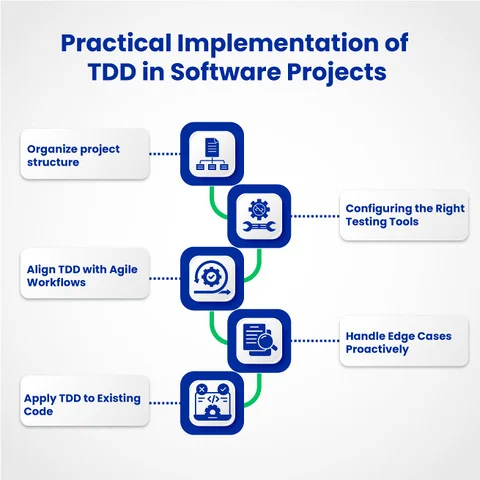
1. Step-by-Step Example of Test-Driven Development
One of the best ways to understand TDD is to walk through a basic test-driven development example.
Let’s consider a feature like a user login system.
In TDD, the developer first writes a failing test (e.g., the user should not log in with an incorrect password). This is the Red phase. Next, they write just enough code to pass the test (Green phase), and finally, they refactor the code for clarity and performance without changing behavior (Refactor phase).
This cycle repeats for each unit of functionality, ensuring that every piece of code has a purpose and passes validation before progressing. In the example above, we illustrated how even simple features can be developed more reliably using a TDD approach.
2. Tools That Support Test-Driven Development
Implementing TDD requires robust testing tools suited to the programming language and framework in use. Popular tools that support TDD include:
- JUnit: Commonly used for testing in Java applications.
- RSpec: A popular choice for Ruby developers.
- PyTest: Widely adopted for Python projects.
- Jest: Frequently used in JavaScript environments.
These tools provide the automation backbone for running unit tests continuously.
In modern development environments, these tools integrate seamlessly into build pipelines, editors, and version control systems, making test-driven software development not only practical but also efficient.
3. Integrating TDD into Agile Development Cycles
TDD naturally complements agile and test-driven development by fitting directly into the sprint planning process.
For example, writing acceptance criteria can easily evolve into writing test cases. When developers begin each task by translating requirements into tests, they can build incrementally with greater clarity and alignment.
Furthermore, pairing TDD with agile ceremonies like daily standups and sprint retrospectives reinforces accountability and improvement. In the section above, we emphasized how aligning TDD with agile workflows helps teams iterate faster without compromising stability.
4. Managing Test Data and Edge Cases in TDD
One challenge in test-driven development in software testing is preparing accurate and diverse test data. Good TDD practices include writing tests for edge cases, such as invalid input or boundary values, not just typical scenarios.
These early safeguards catch bugs that would otherwise remain hidden until production.
Mocking, stubbing, and using fixtures can help simulate real-world conditions without relying on external systems.
5. Scaling TDD for Complex or Legacy Systems
While TDD works smoothly in greenfield projects, integrating it into large or legacy systems is more complex. Developers must start small, often writing tests around existing components before making changes.
Over time, this builds a safety net that allows for broader refactoring and modernization.
What are the Benefits of Applying TDD to Software Development?
The benefits of test-driven development, including better design, fewer defects, and easier maintenance, are even more significant in legacy software modernization projects.
Adopting TDD goes far beyond catching bugs early. It improves the entire software development process. Teams that consistently apply TDD often report better collaboration, higher code quality, and more predictable project outcomes.
When applied properly, TDD offers both short-term and long-term advantages in both startup and enterprise settings.
Now, let’s highlight 5 key advantages of using test-driven development in modern engineering.
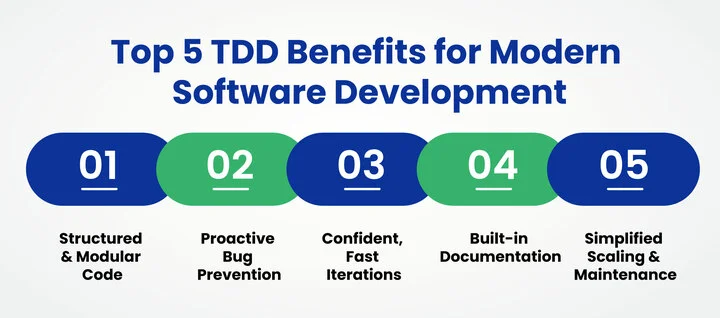
1. Improved Code Quality and Structure
TDD requires developers to think through the intended behavior of code before they begin writing it. This pre-planning results in cleaner, more modular code that’s easier to test and maintain.
Each function is written with a clear purpose, avoiding unnecessary complexity. As discussed earlier, this also supports code refactoring without fear of breaking functionality.
2. Early Bug Detection and Prevention
One of the benefits of TDD is early bug detection, before the code itself. Developers identify problems at the source, not after deployment.
This advantage of test-driven development minimizes the chances of introducing regressions or critical bugs late in the development cycle. Catching errors early also reduces the time and cost associated with rework and firefighting.
3. Gained Developer Confidence and Productivity
TDD provides an immediate feedback loop. When all tests pass, developers gain confidence that the software behaves as expected. Tools like Jest or PyTest enable this real-time validation, allowing issues to surface instantly during development.
This accelerates development speed while reducing the cognitive load of manually tracking issues. In high-pressure environments, this confidence becomes a competitive advantage.
4. Better Documentation Through Tests
One often-overlooked benefit of test-driven development is that it acts as live documentation. Each test describes how a feature should behave, making it easier for new team members to understand system logic.
Unlike traditional documentation, which can become outdated, test suites evolve alongside the codebase.
5. Easier Maintenance and Long-Term Scalability
When projects scale, maintaining quality becomes more difficult. With TDD in place, teams have a safety net that allows them to make changes or add features without unintentionally breaking existing functionality. This ensures software can grow and evolve while remaining stable and secure.
Frequently Asked Questions (FAQs)
2. How Is TDD Different From Traditional Testing?
The core purpose of TDD is to improve code quality by validating each functionality before implementation. This prevents defects early, supports clean architecture, and aligns with modern development practices like Agile and DevOps.
3. Does TDD Work Well With Agile And CI/CD Pipelines?
Yes, TDD aligns perfectly with Agile and CI/CD workflows. It supports rapid, iterative development and continuous integration by enabling early testing, fast feedback, and higher release confidence.
4. What Are Some Popular Tools Used For TDD?
Common TDD tools include JUnit (Java), RSpec (Ruby), PyTest (Python), and Jest or Mocha (JavaScript). These tools automate test execution and integrate seamlessly into modern build pipelines.
5. What Types Of Projects Benefit Most From TDD?
TDD benefits both greenfield and legacy projects. It’s especially useful in fast-paced environments where frequent updates, scalability, and long-term maintainability are crucial.
Taken together, these insights point to one clear takeaway.
Conclusion
Test-driven development has established itself as a practical, forward-thinking methodology that improves code quality, minimizes defects early, and supports long-term maintainability.
Its compatibility with Agile and DevOps workflows makes it an essential part of modern engineering practices, helping teams deliver stable, scalable software even under tight release cycles and evolving requirements.
Organizations that invest in custom software development are increasingly adopting TDD within DevOps workflows to enhance code quality, speed, and reliability.
Additionally, TDD offers the framework for confidently and clearly developing high-quality software, whether you’re introducing a new product or updating an old system.
Tired of patching bugs late in the sprint? We’ll walk you through how TDD helps catch issues early, streamline your workflow, and make scaling smoother.




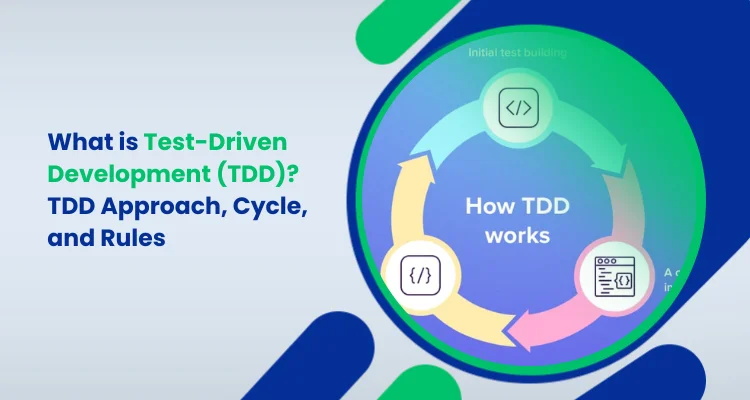



I really enjoyed reading this blog. It breaks down TDD in such a clear and practical way. The examples and comparisons with traditional testing really highlight how powerful this approach is for building reliable, future-proof software.